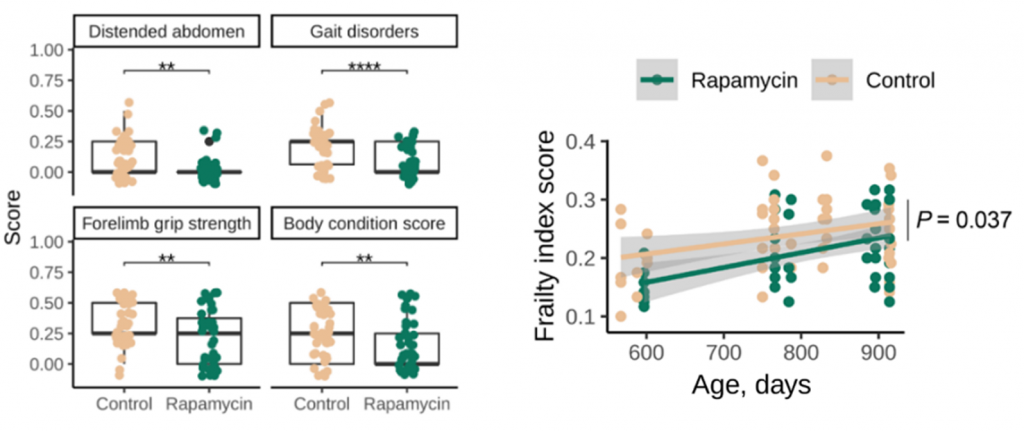Key Points:
- Early life (EL) rapamycin treatment increases lifespan by 10% but inhibits growth in male mice.
- Treatment with rapamycin early in life preserves muscle function.
- Male mice that undergo EL rapamycin treatment exhibit gene profiles consistent with other potent longevity interventions: caloric restriction and growth hormone deficiency.
Identifying potent longevity interventions can be quite tricky. That being said, the FDA-approved drug rapamycin appears to hold anti-aging properties, with rodent studies confirming its ability to preserve muscle upon aging and prolong lifespan when administered in adulthood. However, determining which age to begin supplementing with rapamycin to prolong lifespan may be critical, as there may be trade-offs between lifespan and growth.
In a new study published in Science Advances, Harvard researchers investigate the longevity-boosting effects of EL rapamycin supplementation in mice. The results showed that EL rapamycin treatment prolongs lifespan in a sex-specific manner, with male mice’s lifespan increasing by 10%. What’s more, treated mice remain smaller in size and weight than untreated mice across their lifespan, with the effects being more pronounced in males. The findings also demonstrate that EL rapamycin supplementation preserves muscle function and improves features of aging.
Early Life Rapamycin Increases Lifespan and Improves Physical Fitness
Current evidence suggests there is a positive association between an organism’s maximum life span, time to maturity, and body mass. Furthermore, research indicates that slower-growing mice live longer than their faster-growing counterparts. With this in mind, Shindyapina and colleagues examined whether supplementing mice with rapamycin during development early in life could prolong lifespan by inhibiting growth and time to maturity.
Results showed that rapamycin increases lifespan by 10% in male but not female mice. Additionally, treated mice are smaller in size, gain less weight across their lifespan, and reproduce 4.6 days later than untreated mice. The observed growth effects from EL rapamycin supplementation were more pronounced in males, which could explain the lack of increased lifespan in treated female mice. Notably, a study that explored rapamycin treatment in adulthood also showed that only male mice experienced increased lifespan, demonstrating that rapamycin exerts its longevity-boosting effects in a sex-specific manner.

The Harvard researchers also explored the effects of EL rapamycin treatment on muscle function and physical fitness, which naturally decline with age. After examining an array of aging (frailty) features, including grip strength, balance, and gait speed, the investigators found that treated mice maintain superior physical fitness over untreated mice, suggesting that inhibited growth may be a worthwhile trade-off.

Caloric restriction and growth hormone deficiency are well-established longevity interventions that produce unique gene profiles in model organisms. Accordingly, Shindyapina and colleagues looked at the gene profiles in the kidneys and liver of mice following supplementation and found that treated male mice exhibit genetic alterations similar to those observed with caloric restriction and growth hormone deficiency. Importantly, the investigators found that EL rapamycin treatment significantly decreased the activity of pathways tied to inflammation, a key hallmark of aging that drives a myriad of age-related diseases like Alzheimer’s and heart disease.
Is Rapamycin Treatment Worth It?
Rapamycin is a known inhibitor of mTOR, a nutrient-sensing complex that coordinates cellular functions tied to proliferation (cell growth) and survival. Not only does mTOR inhibition have strong ties to increased longevity, but it also contributes to suppressed tumor growth and limits senescent cells – growth-arrested cells that accumulate with aging. Given that senescent cells accelerate the development of multiple age-related diseases, rapamycin treatment could potentially target numerous aging pathways simultaneously to delay aging features. However, more animal and human studies are needed to confirm this hypothesis.
The study’s findings confirm rapamycin’s safety when taken during development and reaffirm its longevity-boosting properties, meaning we can potentially take charge of our health sooner rather than later. However, it’s important to keep in mind that while rapamycin appears to improve physical fitness and lifespan, there is a potential tradeoff with stunted growth. Whether this matters depends on the individual. That being said, it appears that rapamycin is a powerful longevity intervention that may be worth trying.